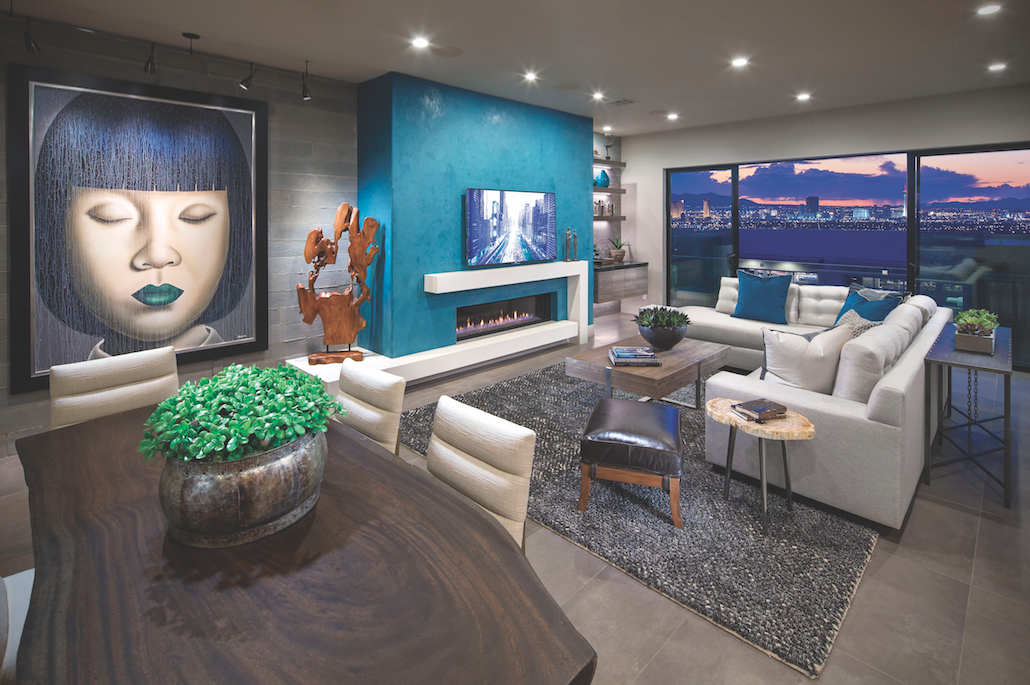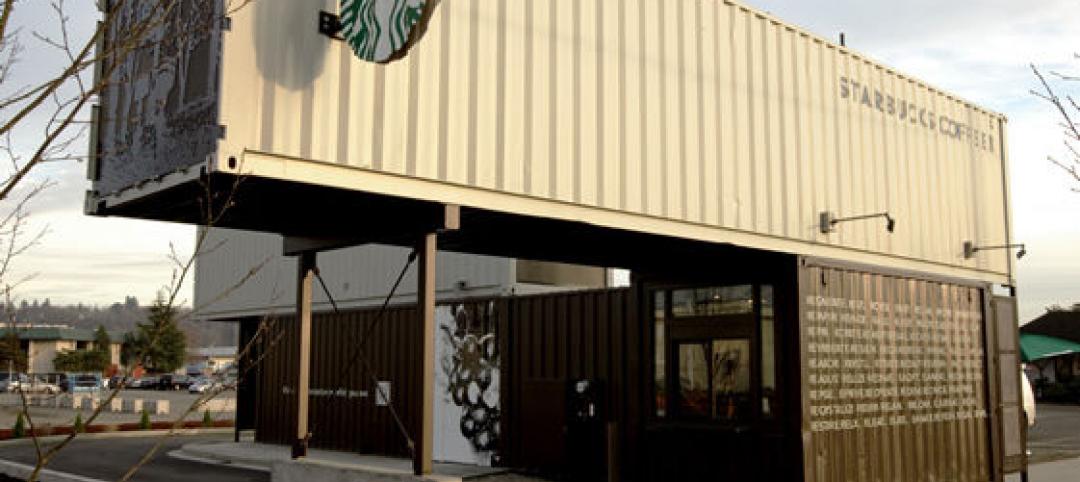In 1991, Tricia Esser joined KTGY Architecture + Planning, a new architecture firm in Irvine, Calif., as Controller. Her timing could not have been worse: 1991 marked the start of the steepest economic downturn in decades.
Despite the gloomy economic picture, Esser believed in the vision the founding partners postulated for their newly minted firm—that talented professionals, sustained by training, desire, opportunity, and teamwork, could be molded into a team environment to produce superior work.
Twenty-seven years later, that philosophy still guides the firm. “We are over the top with never being satisfied with where we’re at,” said Esser, now KTGY’s CEO. At the heart of the firm’s success is its unwillingness to accept the status quo. “That applies to everything from projects to HR to accounting,” she said. “The gas pedal is always down to the floor, but that’s what creates a visionary firm.”
Over the years, that passion has resulted in 578 awards for design excellence, most recently top honors from the Multifamily Pillars of the Industry for Best Community Amenities at AVA NoMa, Washington, D.C., and a Gold from The Nationals for Best Architectural Design of an Attached Community for Vu at MacDonald Highlands, Henderson, Nev.
‘Our philosophy is, “Better together.” We can be better as a company if we’re not focused on ourselves.’
— Tricia Esser, CEO
Still based in Irvine, KTGY—the name is based loosely on the initials of the last names of the founders: Hiro Kinoshita, Jim Thomas, John Tully, Gary Gregson, Bob Yamafuji, and Frank Yonemori—now has offices in Chicago, Denver, Los Angeles, Oakland, Calif., Tysons, Va., and Pune, India. A total of 407 professionals work in 32 states and 12 countries, including China, Turkey, Saudi Arabia, and Japan.
With a growing emphasis on urban infill, the bulk of the firm’s work is vertical. “We want to give people the feel of single-family living in the vertical environment,” said Esser, who was named Partner in 1995, Chief Financial Officer in 1998, and CEO in 2006. “The higher the density, the more vertical, the more excited we get.”
Bruce Dorfman, Senior Managing Director of Trammell Crow Residential’s Northern California division, said KTGY’s “greatest strength” is its designers’ ability to work collaboratively with the owner. “We lay in what we view as the program and challenge them to create a design that fits the program, not the architect’s ego,” said Dorfman, who has been a KTGY client for two decades.
Dorfman also praises KTGY for its careful attention to project economics. “They have a good sense of high-quality design that you can afford to build. That’s incredibly important,” he said. Currently, Trammell Crow and KTGY are partnering on several projects in Northern California, including 360 5th Street, San Francisco, a $95 million development of 127 apartments and 9,300 sf of retail and creative workspace.
TOUGH PROBLEMS, CREATIVE SOLUTIONS
KTGY’s problem-solving skills were put to the test on Anthem House, a luxury rental community with a sweeping view of Baltimore Harbor. Bozzuto Development, Greenbelt, Md., hired KTGY to give the project what Tess Guinn, Bozzuto’s Development Manager, called a “fresh, West Coast aesthetic.” KTGY’s designers worked with the developer to optimize the location while also creating an appropriate sense of scale for the neighborhood.
The topography of the site was marked by a sharply downward-sloping grade differential. KTGY resolved that problem by designing a massive mechanically stabilized earthen wall—over 20 feet high—on Key Highway to coordinate the utilities connection. “It was a brilliant way to handle that,” Guinn said.
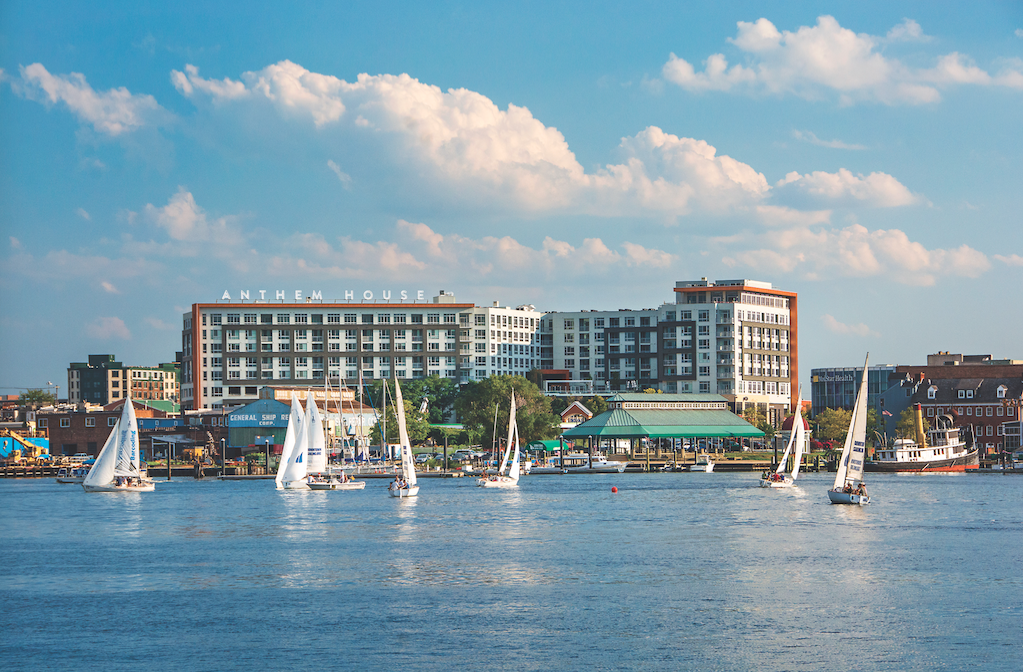
KTGY designed Baltimore’s Anthem House mixed-use apartment/retail property for the Bozzuto Group, War Horse Cities, and Solstice Partners. “The S-shape design is very sensitive to the surrounding landscape and neighborhood,” said Bozzuto Development’s Tess Guinn. “You have common areas looking out on the harbor. That solidifies Anthem House as part of the neighborhood.” The podium-based structure houses 292 apartments, 19,200 sf of retail, and a 3,500-sf sky lounge, on 2.67 acres. Photo: John Bare
KTGY was also able to modify the building’s construction process, which was based on the Infinity Structural System. Employing pre-panelized load-bearing metal stud walls, the system can produce metal-and-concrete floor spans up to 27 feet in length.
The Infinity system is most effective in floor plans that are identical as you go up. In this case, however, the client wanted the biggest premier units at the top for the best view of the harbor. Fortunately, the exterior walls and the corridor walls on the eighth floor were bearing walls. This gave the designers the flexibility to shift the interior walls and make the upper units bigger. “KTGY was able to deliver these fabulous units and work through the coordination of the construction system,” Guinn said.
PUTTING R&D ON THE FRONT BURNER
KTGY’s focus on innovation is most evident in its R&D Studio, a department devoted entirely to exploring the built environment and creating new approaches to design.
“A lot of firms talk about R&D, but it’s smoke and mirrors,” said KTGY Principal David Senden, who joined KTGY in 2002 and is a member of the Board of Directors. “They have their people come in at night and talk over a few beers, and they call that R&D. We said, ‘Let’s make this real R&D.’ Let’s have a studio of people who are overhead positions, and let’s try to push the thinking forward.” Senden said the underlying premise of the R&D Studio is to get KTGY staff to see themselves first and foremost as problem solvers.
The R&D Studio has been so successful that the firm now has three full-time staff—two permanent slots, one rotating position—to look at such areas of interest as micro-unit design, multigenerational housing, infill farming, and urban multiuse senior housing.
Out of the R&D Studio came Park House, a residential concept based on the notion of a carless environment. With the meteoric rise in ride sharing and the emergence of self-driving cars, thousands of downtown parking garages might someday sit vacant. How might these valuable sites be converted to housing? Park House imagines using modified shipping containers to create apartments.
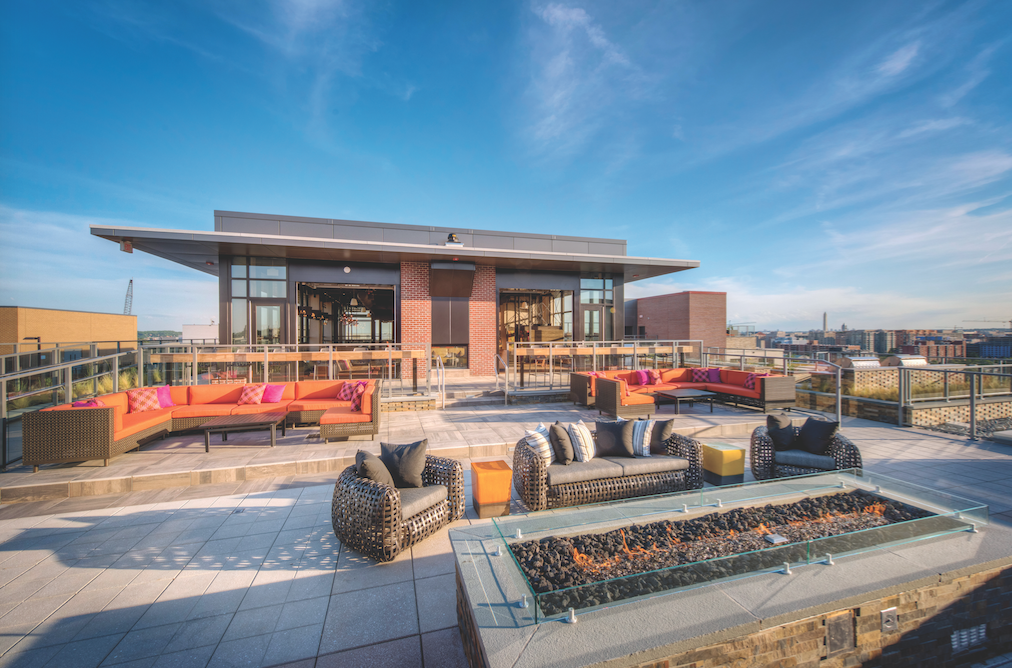
The rooftop at AVA NoMa, a 13-story infill complex of 438 apartments, a 6,700-sf retail food court, and 303 below-grade parking spaces. “NoMa” is short for “north of Massachusetts Avenue,” a trendy Washington, D.C., neighborhood (you can just make out the Washington Monument at right in the photo). AvalonBay Communities was KTGY’s client. Photo: © Sam Kittner
“We don’t expect any of the R&D solutions will be built exactly as we’ve conceived them,” said Senden, a Building Design+Construction “40 Under 40” honoree (Class of 2009). “It’s like the concept car at the auto show. It gets people talking, and pieces of the car will make it into the marketplace.”
That kind of imaginative thinking is fueling KTGY’s work in repurposing abandoned or underused shopping malls for multifamily living. “We’re working with a couple of large mall owners to bring apartments into jumbo malls,” said KTGY Board Member Manny Gonzalez, FAIA, LEED AP, Managing Principal of the Los Angeles office. “Senior living is an excellent option for that kind of housing.
“There’s a lot of opportunity in this market, using land options people hadn’t thought of 10 years ago,” said Gonzalez, an eighth-generation Angelino. His ancestor, António José Rocha, a Portuguese fisherman, arrived in 1814 and was later awarded the land grant for Rancho La Brea. The family adobe once served as the City-County Municipal Building. “It’s still standing in the LA Farmer’s Market,” said Gonzalez.
RUNNING THE ENTITLEMENT MAZE
Chairing KTGY’s Board of Directors is Jill D. Williams, AIA, who joined the firm in 1991 and became Managing Principal of the firm’s Oakland, Calif., office in 2001. One of the toughest parts of building multifamily developments in California, she said, is the labyrinthine entitlements process.
“We enjoy the push from local jurisdictions and neighbors to make a great project,” she said, but she admits that sometimes the wear and tear on the nerves can be gruesome. “The years, the commitment it takes from the builders and developers—that experience doesn’t work for everybody.”
The fun part, she said, is the initial discussions with a builder or developer as to how a particular site could be used most effectively—“what it can be, how much new housing can you put on the site, how to be a good neighbor.”
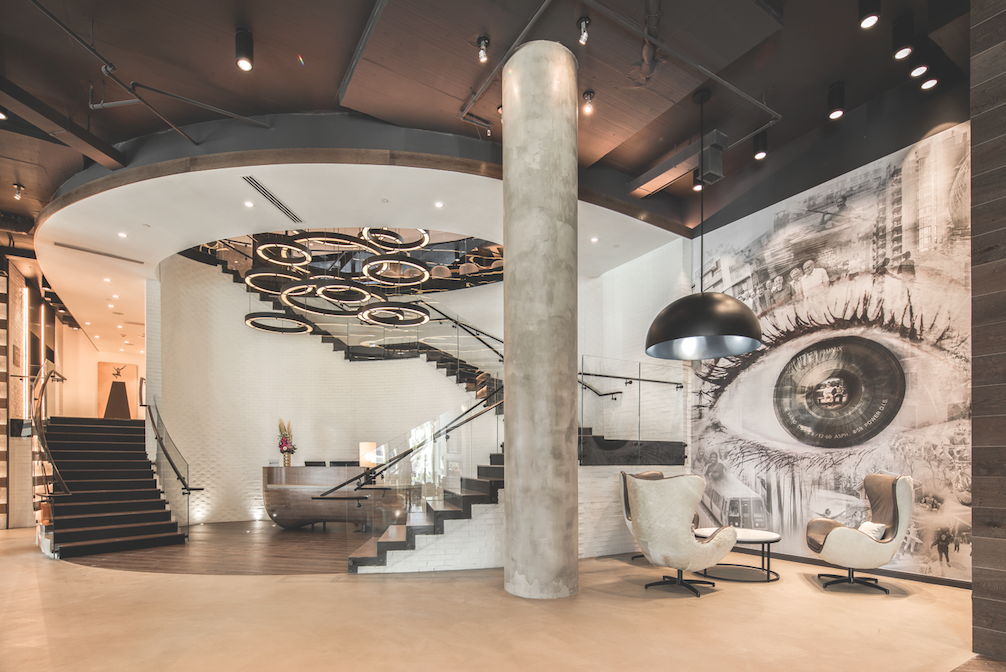
A bronze and stainless steel sculpture by Zachary Oxman creates a dramatic visual statement for the lobby of Aperture Apartments, a 421-unit luxury residence across from a Metro station in Reston, Va. KTGY designed the six-story project for Bozzuto Group and Veatch Commercial Real Estate. Photo: Ray Cavicchio
Williams is excited about two projects in the works in Oakland:
• The $123 million Alexan Webster, 234 luxury apartments, 15,000 sf of retail (with Trammell Crow Residential).
• Fourth Street East, where 90 modular units are being built on a former parking lot; across the street, another 240 units are being formed in the renovation of the historic 1937 Cost Plus World Market office building (with Carmel Partners). The two seven-story structures are using boxcar and shipping container materials that recall Jack London Square as the site of the first railroad connection to the Port of Oakland.
“Those projects have been a while in the making,” said Williams. “We can’t wait to see what the housing will do for Oakland.”
LEARNING TO LEAD THE KTGY WAY
A few years back, KTGY management began to sense that its commitment to nurturing the firm’s next generation of leaders was slipping. “One of the tough things about growing a design firm is how can you still be a big company versus seven little groups that are all spread out in the individual offices,” said Esser.
In response, the firm created ELEVATE Leadership, an intensive program to connect up-and-coming leaders with each other and with the KTGY Board of Directors and shareholders. “We’ve educated our leadership in the management and business of KTGY in ways we couldn’t have done before,” said Esser. “We’re putting the same level of excellence on improving things like public speaking skills as we have for architecture and planning. It’s made us stronger. We’re speaking the same language, and we just know each other better.” So far, 19 staff members have completed the 12-month program.
Esser sees mixed-use as the next big opportunity for the firm. “With our residential background and knowledge, we can lead the mixed-use effort,” she said. “We can look at how people want to live and translate that into retail, commercial, residential, even senior living.”
After all, said Esser, “How people live is where KTGY lives.”
UNIVERSITY HOUSING FROM KTGY: ‘DYNAMIC, INTERACTIVE COMMUNITIES’
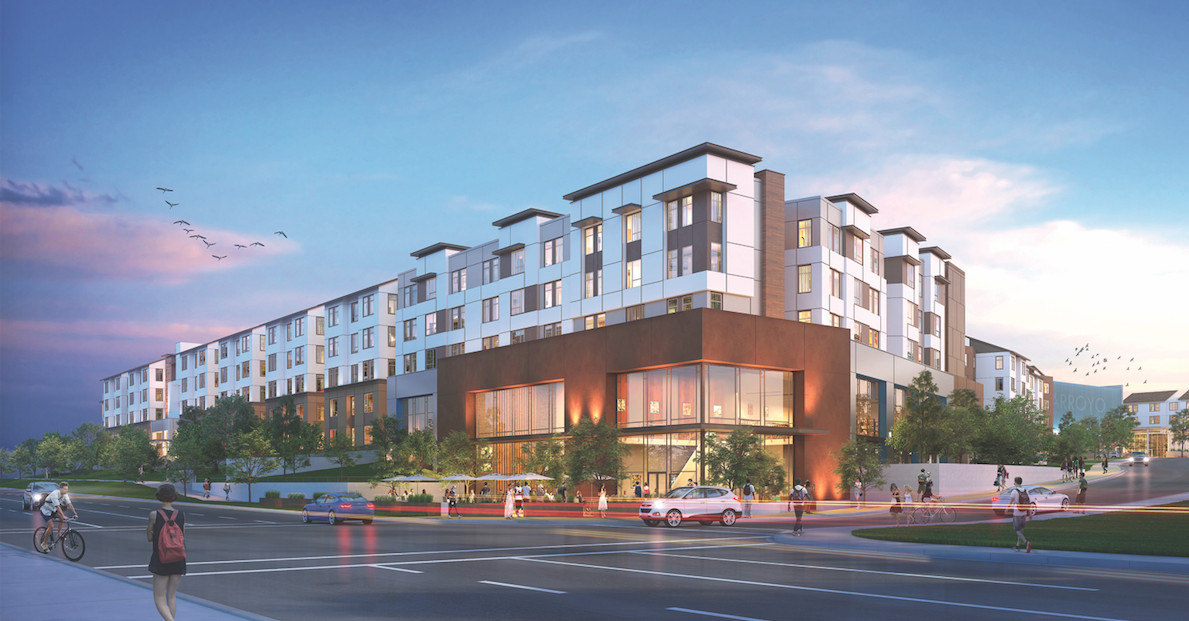
Student housing is an important market specialty for KTGY. Jason Wills, Senior Vice President of on-campus development for American Campus Communities, Austin, Texas, said the design firm focuses on the elements that create good student housing communities. “We’ll end up with very dynamic interactive communities and buildings that encourage circulation and socialization,” said Wills, whose company has been a KTGY client for nearly 20 years. “These are good-quality spaces. To me, the proof of great architecture is when you open the building and you’re full. People want to stay in communities that have the right units and feel.”
KTGY has been developing UC Irvine’s 13.3-acre East Campus housing complex for ACC since 2007. As originally designed, the community would have provided about 1,300 beds; after reevaluating its housing needs, the university asked KTGY to redesign the community to provide 2,351 beds. Phase IV will provide 652 units in a live/learn complex with a classroom space on the lower level of the community center.
CAPTION: UC Irvine’s East Campus Phase IV calls for two residential buildings surrounding The Hub, a 502-car parking structure and 684-bicycle storage facility. The edifice steps up to accommodate the 20-foot vertical grade change; landscaped terraces were created. KTGY designed the 652-room, 2,351-bed complex for American Campus Communities. Rendering: KTGY Architecture + Planning
Related Stories
| Oct 18, 2013
Researchers discover tension-fusing properties of metal
When a group of MIT researchers recently discovered that stress can cause metal alloy to fuse rather than break apart, they assumed it must be a mistake. It wasn't. The surprising finding could lead to self-healing materials that repair early damage before it has a chance to spread.
| Oct 7, 2013
10 award-winning metal building projects
The FDNY Fireboat Firehouse in New York and the Cirrus Logic Building in Austin, Texas, are among nine projects named winners of the 2013 Chairman’s Award by the Metal Construction Association for outstanding design and construction.
| Oct 7, 2013
Reimagining the metal shipping container
With origins tracing back to the mid-1950s, the modern metal shipping container continues to serve as a secure, practical vessel for transporting valuable materials. However, these reusable steel boxes have recently garnered considerable attention from architects and constructors as attractive building materials.
| Oct 4, 2013
Sydney to get world's tallest 'living' façade
The One Central Park Tower development consists of two, 380-foot-tall towers covered in a series of living walls and vertical gardens that will extend the full height of the buildings.
| Oct 4, 2013
Mack Urban, AECOM acquire six acres for development in LA's South Park district
Mack Urban and AECOM Capital, the investment fund of AECOM Technology Corporation (NYSE: ACM), have acquired six acres of land in downtown Los Angeles’ South Park district located in the central business district (CBD).
| Sep 24, 2013
8 grand green roofs (and walls)
A dramatic interior green wall at Drexel University and a massive, 4.4-acre vegetated roof at the Kauffman Performing Arts Center in Kansas City are among the projects honored in the 2013 Green Roof and Wall Awards of Excellence.
| Sep 23, 2013
Six-acre Essex Crossing development set to transform vacant New York property
A six-acre parcel on the Lower East Side of New York City, vacant since tenements were torn down in 1967, will be the site of the new Essex Crossing mixed-use development. The product of a compromise between Mayor Michael Bloomberg and various interested community groups, the complex will include ~1,000 apartments.
| Sep 20, 2013
August housing starts reveal multifamily still healthy but single-family stagnating
Peter Muoio, Ph.D., senior principal and economist with Auction.com Research, says the Census Bureau's August Housing Starts data released yesterday hints at improvements in the single-family sector with multifamily slowing down.
| Sep 19, 2013
What we can learn from the world’s greenest buildings
Renowned green building author, Jerry Yudelson, offers five valuable lessons for designers, contractors, and building owners, based on a study of 55 high-performance projects from around the world.
| Sep 19, 2013
6 emerging energy-management glazing technologies
Phase-change materials, electrochromic glass, and building-integrated PVs are among the breakthrough glazing technologies that are taking energy performance to a new level.


